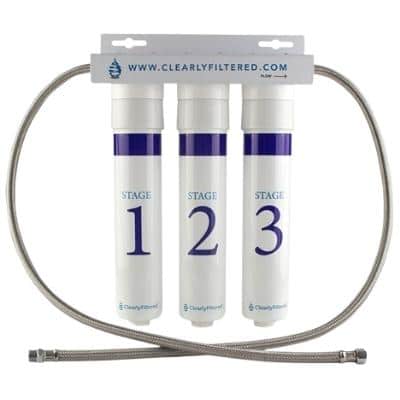
We installed and tested the Clearly Filtered Under Sink Water Filter on a shared, treated well water supply in Colorado. Here, we’ve shared the results of our own hands-on testing of the filter’s contaminant reduction abilities, filtration speed, design quality, ease of setup and maintenance, and overall value for money.
What We Like
What We Don’t Like
| Price | $550.00 |
| Contaminants Reduced | 232+ |
| Certifications | NSF 42, 372 |
| Process | Carbon + Ion Exchange |
| Filter Capacity | 2,000 gallons |
| Annual Cost | ~$440 |
| Warranty | Lifetime |
Table of Contents
📊 Scoring Data
We wanted to gain a comprehensive understanding of the Clearly Filtered Under-Sink Filter’s overall performance, so we tested the system across 6 key categories. We then combined and weighted the scoring data from each category to obtain an overall score. See below for the key scoring data that we gathered for the CF under sink filter.
| Criteria | Results |
|---|---|
| Overall Score | 8.79 |
| Health Related Contaminants | 95 |
| Aesthetic Related Contaminants | 99 |
| Performance Certification | Certified for <1% of reduction claims |
| Filtration Rate | 1.08 GPM |
| Component Quality | Outstanding |
| Component Certification | Certified |
| Setup | Outstanding |
| Servicing Requirements | Outstanding |
| Costs | $0.22/ gallon |
| Warranty Length | 2 years |
| Shipping | Free shipping, all orders to all states |
| Returns | 30 days |
🎬 Video Review
🚰 Contaminant Reduction
Score: 8.98Our top priority was to assess the Clearly Filtered Under-Sink Water Filter’s ability to reduce or remove contaminants, since this is the primary reason why people install a water filter.
There were two scoring sub-categories that we combined to give us an overall contaminant reduction score: the filter’s performance score from our own lab testing, and its “certification” score (dictated by whether or not a water filter is performance-certified by the NSF, WQA, or IAPMO, and for how many contaminants reduced).
Our Performance Testing
Score: 9.20
We used a laboratory testing kit by SimpleLab Tap Score to test the Clearly Filtered Under Sink system’s contaminant reduction performance. We received a sample kit in the mail, which contained the tools we needed to take our water samples before shipping them to the lab for analysis.

We took two samples of water from our kitchen faucet: one before installing the system, and one post-installation, after running ~10 gallons through the filters.
Our test results were delivered in an interactive report, and we used the data in this report to score the Clearly Filtered Under Sink filter’s contaminant reduction performance.
Below, we’ve listed the contaminants that were present in our unfiltered tap water, and how these were reduced by the Clearly Filtered system.
Health-Related Contaminants
Score: 9.50
Our unfiltered water contained trace levels of 10 contaminants with possible health effects: uranium, chloroform, total THMs, copper, fluoride, nitrate, barium, molybdenum, strontium, and sulfate.

We were the most concerned about the first five contaminants on this list, since these were all detected at concentrations that exceeded Tap Score’s HGL.
| Parameter | Type | Measurement | Pre-Filtration | Post-Filtration | % Reduction |
|---|---|---|---|---|---|
| Chloride | Inorganics | mg/L | 28.5 | 27.7 | -2.81% |
| Magnesium | Minerals | mg/L | 7.32 | 6.91 | -5.60% |
| Sulfate | Inorganics | mg/L | 8 | 6.3 | -21.25% |
| Nitrate (as N) | Inorganics | mg/L | 4.2 | 3.2 | -23.81% |
| Hardness (Ca,Mg) | Properties | mg/L | 106.3 | 34.45 | -67.59% |
| Hardness (Total) | Properties | mg/L | 106.96 | 34.45 | -67.79% |
| Grains per gallon | Properties | Grains | 6.26 | 2.01 | -67.89% |
| Hardness | Properties | mg/L | 106 | 34 | -67.92% |
| Calcium | Minerals | mg/L | 30.5 | 2.4 | -92.13% |
| Copper | Metals | mg/L | 0.31 | 0.0019 | -99.39% |
| Total THMs | Disinfection Byproducts | μg/L | 2.08 | 0 | -100.00% |
| Chloroform | Disinfection Byproducts | μg/L | 2.08 | 0 | -100.00% |
| Fluoride | Inorganics | mg/L | 0.9 | 0 | -100.00% |
| Barium | Metals | mg/L | 0.0228 | 0 | -100.00% |
| Strontium | Metals | mg/L | 0.135 | 0 | -100.00% |
| Uranium | Metals | mg/L | 0.0096 | 0 | -100.00% |
| Potassium | Minerals | mg/L | 0 | 10.1 | #DIV/0! |
| Molybdenum | Metals | mg/L | 0.0019 | 0.002 | 5.26% |
| pH | Properties | pH | 7.3 | 9.3 | 27.40% |
| Bicarbonate | Minerals | mg/L | 82.75 | 108.87 | 31.56% |
| Total Dissolved Solids | Properties | mg/L | 164 | 317 | 93.29% |
| Sodium | Minerals | mg/L | 11.2 | 50.3 | 349.11% |
| Carbonate | Minerals | mg/L | 0.08 | 10.02 | 12425.00% |
Some of the known health effects of these contaminants are:
- Developmental effects
- Kidney and liver problems
- Immune function issues
- Carcinogenic (cancer-causing) effects
- Skeletal health issues
- Gastrointestinal effects
Our filtered water test results showed that the Clearly Filtered Under-Sink Water Filter had completely eliminated four of the five contaminants detected above the HGL: uranium, chloroform, total THMs, and fluoride. Copper was also almost completely removed, with a 99.39% reduction, from 0.31 PPM to 0.0019 PPM.
As for the contaminants detected below the HGL, the Clearly Filtered system removed 100% of barium and strontium.
Nitrate was only reduced by 23.81%, from 4.2 PPM to 3.2 PPM, and sulfate by 21.25%, from 8 PPM to 6.3 PPM.
Molybdenum was reduced by 5.6%, from 0.0019 PPM to 0.002 PPM. But none of these contaminants are claimed to be reduced by Clearly Filtered, so we were unsurprised by this result.
Generally, we were pleased with the Clearly Filtered Under Sink Water Filter’s ability to remove contaminants with health effects, and the big reassurance for us was that the system reduced all contaminants to below Tap Score’s HGL, ensuring the safety of our drinking water.
Aesthetic Contaminants
Score: 9.90
The only aesthetic contaminant that was detected in our unfiltered water was chlorine. Our chlorine test strip detected around 1 PPM of this contaminant in our unfiltered water, and this was an unsurprising result because our water is disinfected with chlorine before it’s distributed around the shared well system.
In our post-filtration test, no chlorine was detected. This is almost certainly the work of the system’s granulated coconut carbon filtration media, which uses adsorption to reduce chlorine to untraceable levels.
Minerals & Salts
We don’t usually discuss minerals and salts when we’re evaluating the performance of a non-RO system, and this isn’t currently a sub-category that affects a filter’s overall score.
But in our testing of the Clearly Filtered Under-Sink Water Filter, we noticed some interesting changes to our water’s concentrations of select mineral ions, and we want to theorize why we think these changes might have occurred.
Initially, our water contained 11.2 PPM of sodium. After filtering it through the CF system, this shot up to 50.3 PPM – a 349.107% increase. Additionally potassium was detected at 10.1 PPM where it was absent in the raw water test.
We also noticed a change in the concentration of calcium and magnesium minerals in our water.
Magnesium levels dropped slightly, from 7.3 PPM to 6.91 PPM (just under a 6% decrease). But calcium was reduced by over 92%, from 30.5 PPM to just 2.4 PPM.
We don’t believe this result is intentional since calcium and magnesium have taste and health benefits in tap water, and such a substantial increase in sodium may affect water quality. We actually found a customer review on the CF website commenting that the water tasted like baking soda for “the first few gallons”, likely due to this initial spike in sodium when the filter is new:
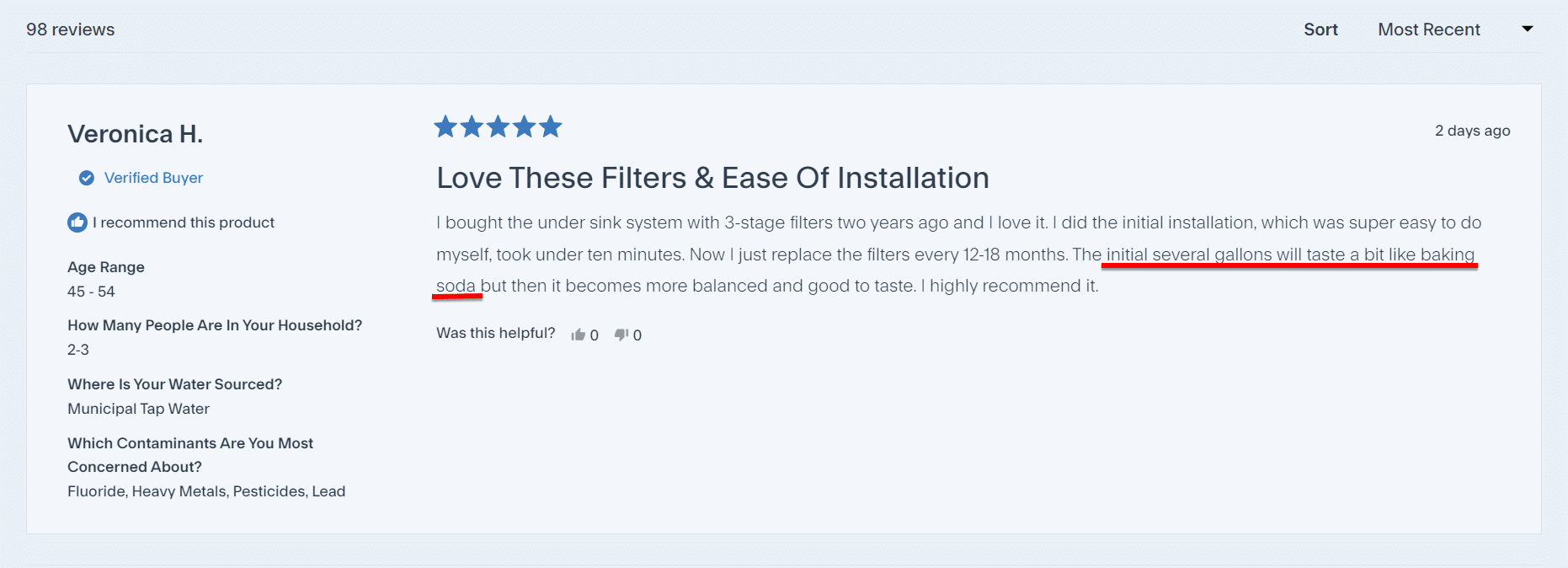
For some context, we conducted our filtered water test on the same day after installing the Clearly Filtered Under-Sink system, after using the water all day. By that point, we’d filtered maybe 8-10 gallons through the system.
Why do we think the concentrations of these minerals and salts were altered by the filtration process?
Our theory is that one of the filter cartridges contains a combined sodium and potassium-loaded ion exchange resin, which exchanges these ions with minerals and metals like calcium, magnesium, and uranium. This hypothesis would explain the reduction in calcium and magnesium and the addition of potassium and sodium that we saw in our results.

Do these results spell bad news? No – the EPA recommends that sodium concentrations in drinking water not exceed 30 to 60 PPM to avoid adverse taste effects, so while our water contained enough sodium to affect taste, it was still safe to drink for folks who aren’t on a low-sodium diet. A report by the WHO also notes that there’s currently no evidence to suggest that the potassium levels in municipally treated drinking water (even water treated with potassium permanganate) pose any human health risks.
In terms of the calcium reduction we saw, most of us get the majority of calcium from the foods in our diet, so removing it from your drinking water shouldn’t lead to deficiencies.
That said, if you’re on a low-sodium diet, or if you really don’t want to reduce the healthy minerals in your water, you might want to rethink this system.
Performance Certifications
Score: 7.00
We can only measure the Clearly Filtered Under-Sink filter’s ability to reduce the select contaminants detected in our water supply. That’s why we also wanted to know whether or not the system had performance certifications to help us understand its broader contaminant reduction abilities.
The CF system has a WQA performance certification to NSF/ANSI Standard 42, for the reduction of chlorine, tastes, and odors.
Note: The system has been third-party tested to remove 232+ contaminants (the results are viewable online), but third-party data isn’t as reassuring as official performance certifications that can only be obtained if a filter passes a rigorous testing process.
We were pleased to see this certification, but a little disappointed that Clearly Filtered hasn’t yet invested in certifications for some of the more concerning contaminants it claims to reduce, like lead, arsenic, and PFAS. That’s why the system didn’t get the highest score from us in this category.
🚦Filtration Rate
Score: 9.00As an under-sink system, the Clearly Filtered unit connects directly to your cold water line. This gives it an advantage over Clearly Filtered’s Water Filter Pitcher, which uses a slower and steadier gravity filtration process.
With the under-sink system, we knew we’d have access to filtered water on demand from our faucet – but what kind of filtration speed could we expect?
Clearly Filtered doesn’t disclose the exact flow rate for this model. Generally, the other under-sink water filters we’ve tested in the past have a flow rate of between 0.5 and 1.5 GPM, so we expected the Clearly Filtered unit to be within this range.
After installing the system, we timed how long it took to fill a glass of water from our high-flow faucet. We filled 2 cups in 6.95 seconds, which is equal to a flow rate of 1.08 GPM – so around half the speed that you’d usually get from your kitchen faucet.
We thought the flow rate was pretty good for an under-sink filtration system, although not the fastest we’ve ever come across in this category.
📐 Design
Score: 9.70The Clearly Filtered 3-Stage Under Sink Water Filter is a tall, relatively slim unit with a simplistic, space-saving design. Our unit consisted of a filter housing bar, which the three separate filters attached to. Also included were two plastic push fittings, flexible inlet and outlet tubing, and screws (for if we wanted to mount the system on a wall).
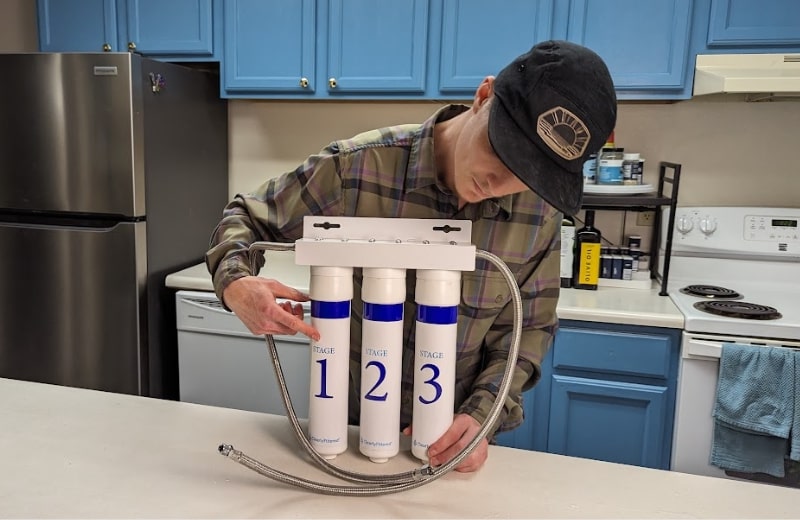
Design-wise, as with many of the Clearly Filtered products we’ve tested, the Under-Sink Water Filter System is pretty basic. It definitely isn’t dressed to impress – we weren’t blown away by some of the high-tech features we see on reverse osmosis systems, like filter lifespan trackers and TDS readers.
But our main priority was to remove as many contaminants from our water as possible without the negative side effects of RO, and in this respect, the Clearly Filtered system came through. We’ve tested enough water filters to know that the mark of a great system isn’t necessarily the outside appearance.
That said, we still have high expectations for all water filters – especially systems directly connected to your water line – when it comes to design quality and durability.
Additionally, as with our contaminant reduction testing, we know that our own experience with a product’s design has limitations, which is why we also look for official certifications for design safety and quality.
Component Quality
Score: 9.5
We awarded the Clearly Filtered Under-Sink Water Filter a high component quality score because we were generally very pleased with the system’s design materials.
We noted that the unit felt solidly made and durable, with no small, flimsy parts that could snap or wear over time.
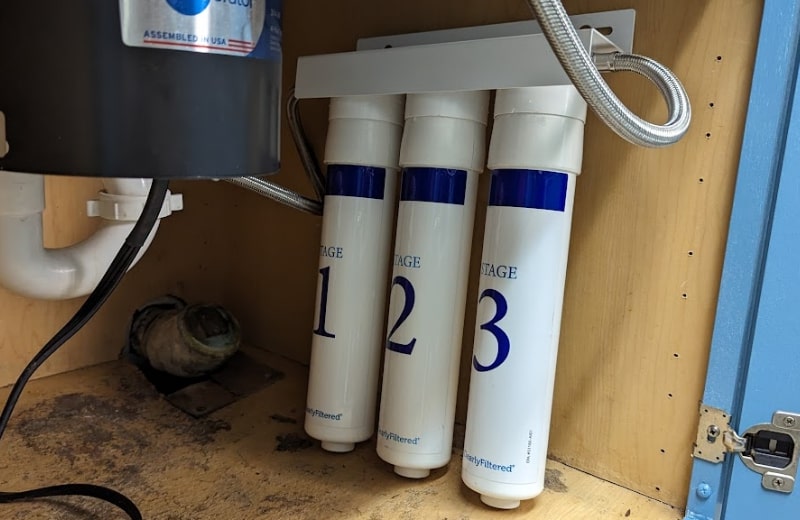
The only reason why the system didn’t get the very best score in this sub-category is that it uses plastic in its design. Clearly Filtered doesn’t name the exact plastics used. We only know that they’re BPS and BPA-free medical-grade materials.
Plastic is commonly used in water filtration systems because it’s cheap, pliable, and lightweight. But if you want to avoid your exposure to plastic as much as possible, you might want to look at a low-plastic alternative, like a stainless steel countertop filtration system or glass water filter pitcher.
Certification
Score: 10.00
The Clearly Filtered Under-Sink Water Filter has a WQA certification to NSF/ANSI Standard 372, which confirms that the unit is made from lead-free materials.
It’s also certified for materials safety as part of its NSF 42 performance certification, so it got the best score from us in this category.
Filter Materials & Media
There are three filters in the Clearly Filtered Under-Sink Water Filter System:
- The advanced priming filter, stage 1, is made from granulated coconut carbon and reduces chlorine, VOCs, and chemicals that affect water’s taste and odor.
- Filter stage 2, the heavy metals & VOC filter, uses a “special blend” that reduces pesticides, herbicides, arsenic, PFAS, and heavy metals.
- The third filter, the fluoride and arsenic filter, uses Clearly Filtered’s “proprietary breakthrough fluoride reduction technology” that isn’t made from activated alumina or bone char, and isn’t reverse osmosis.
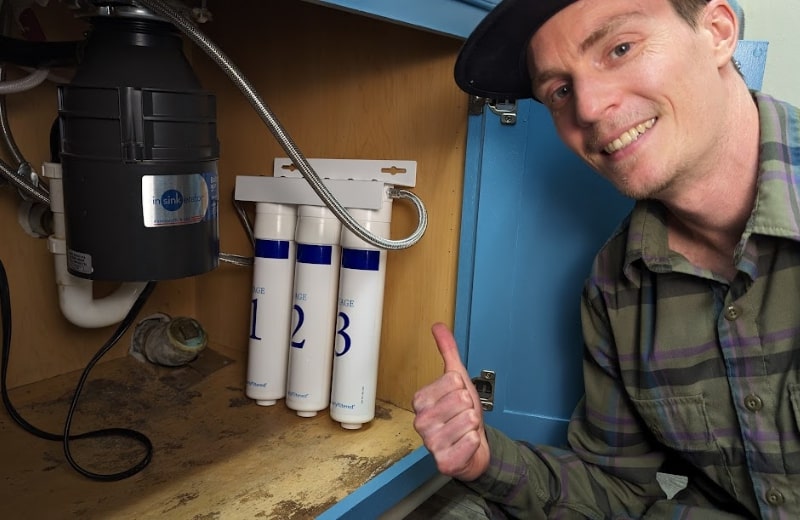
So, there’s some secrecy when it comes to the exact materials used in the system, likely because Clearly Filtered doesn’t want its design to be copied. But we do know that the system contains granulated carbon, and we also theorized that it contains some form of ion exchange resin. Both of these filter media are widely used in water filtration systems and have been studied for over a decade. We could find no evidence that questions their safety when used for this purpose.
⚙️ Setup
Score: 9.50We awarded the Clearly Filtered Under-Sink filter’s setup score based on how long it took us to install, and how easy we found the process.
When it comes to installing under-sink systems, we’ve had mixed experiences in the past. Some, like RO systems, are challenging to install, and we’ve often resorted to hiring a plumber at an extra expense.
So we were relieved to see that the Clearly Filtered system is designed to be easy to install, with just a few parts, no drain line, and no dedicated faucet. It’s also a non-permanent installation, so you can still use it if you’re renting.
The whole process took us 15 minutes from start to finish, and there were less than 5 steps involved.
We just shut off our under-sink water supply, disconnected our cold water line from the cold water valve, and connected the inlet and outlet hoses. We then had to flush the system by leaving the faucet on for 3-5 minutes (we collected the water and used it to water our plants to avoid waste).
🔧 Maintenance
Score: 9.75In terms of maintenance, we only had to think about the filters.
The system was both easy and affordable to maintain, awarding it a high score in this category.
Servicing Requirements
9.50
One of the reasons why an under-sink water filtration system can seem unappealing is that it has multiple filters that need to be replaced, which can get confusing and expensive.
But the Clearly Filtered Under Sink System surprised us on both counts here.
In terms of its servicing requirements, three of its filters have the same lifespan, so we had the convenience of being able to change them at the same time, rather than separately.
We found changing the filters pretty simple – you’ll just have to turn off the cold water under the sink, open the faucet to relieve the pressure, screw off the old filters from the housing bracket, and screw the new ones in place.
Costs
Score: 10.00
On the cost front, the CF system’s maintenance cost was affordable at around $0.22 per gallon. In comparison, Clearly Filtered’s Water Filter Pitcher has a cost per gallon of around $0.55 – over double the under-sink system’s, despite only having a single filter to replace.
The takeaway? Multi-filter systems are often actually more affordable to maintain in the long run, and we’ve definitely noticed this in our testing.
🏢 Company
Score: 9.00Finally, we evaluated Clearly Filtered as a company, including its warranty, returns, and shipping offerings.
Clearly Filtered got a good score here, but its returns offering stopped it from getting the top score in this category.
Warranty
Score: 10.00
All Clearly Filtered products are backed by a limited lifetime warranty, which means they’re warranted for 24 months after purchase. Under the warranty, you may be eligible for a replacement system if you discover an issue caused by faulty workmanship or materials. The warranty doesn’t apply to the filters themselves.
Clearly Filtered says that all its products are individually inspected before shipping. It was good to know that we could contact customer support if we felt that our filter system was defective (which, thankfully, it wasn’t).
View Clearly Filtered’s warranty terms here.
Shipping
Score: 10.00
Clearly Filtered’s shipping policy is as good as we’ve seen: the company offers free shipping to all orders (with no minimum spend) to all states.
Orders are typically shipped and received within 5-10 business days after they have been processed.
View Clearly Filtered’s shipping policy here.
Returns
Score: 8.00
The Clearly Filtered Under-Sink Water Filter comes with a 30-day satisfaction guarantee, which entitles customers to an exchange or full refund within 30 days of receiving the order.
It was good to know that we could return our system within this time if we weren’t happy with it for whatever reason, and we’d get a full refund.
There are no restocking fees or hidden costs associated with returns. The only thing that Clearly Filtered doesn’t cover is the return shipping fee – that comes out of the customer’s pocket.

